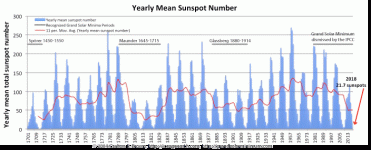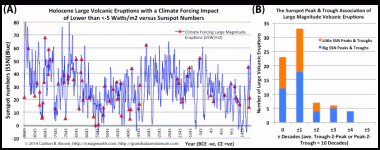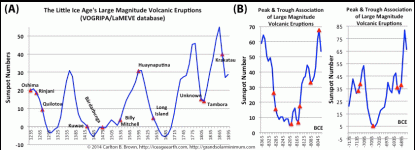The large volcanic eruptions that occurred during the Little Ice Age were associated with its grand solar minima or maxima. Such large magnitude volcanic eruptions had disastrous consequences on global agriculture through cold, ice, drought, and flooding. Scientists tell us that if a Laki-like volcanic eruption (Iceland, 1783) occurred today, the global crop production losses would be in the region of one year’s food supply for one-third of the world’s population. There is no publicly available plan to manage such a global catastrophe. After all the Intergovernmental Panel on Climate Change dismissed or did not detail the prospect of large volcanic eruptions in its climate predictions and risk assessments provided to our governments.
A grand solar minimum represents a magnetically quiet sun
Yearly mean sunspot numbers covering Solar Cycles 1-24 between 1700 and 2018. This highlights an ...
This grand solar minimum portends catastrophic climate-forcing volcanic eruptions
Grand solar minima and maxima ±1 decade represent high-risk periods for climate-forcing volcanic ...
Climate-forcing volcanic eruptions during the Little Ice Age’s grand solar minima
Grand solar minima and maxima represent high-risk periods associated with the “triggering” of ...
Climate-forcing volcanic eruptions correlate with solar activity
Since the Holocene Climate Optimum 8,000 years ago (Arctic), a statistically significant inverse ...




